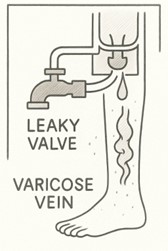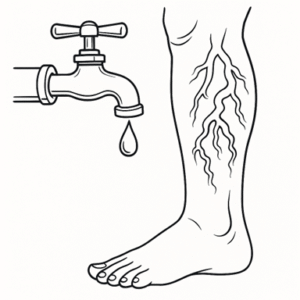Prof. Kittipan Rerkasem
Leg Vein Clinic Thailand
Many patients consulting for varicose veins often hear the doctor say:
“You have leaking vein valves.”
The most common responses are:
“Is the blood leaking outside?”
“Does the blood come out of the vein?”
This confusion is very common. The word “leak” sounds like fluid spilling out—but venous valve leakage **does NOT mean blood escapes outside the body**.

This cartoon descripts the leakage valves
How the Venous System Works
The body has two major vessel systems:
- **Arteries** – carry blood from the heart to the body
- **Veins** – return blood back to the heart
Veins in the legs must work *against gravity* to bring blood up from the feet.
Three main mechanisms help the blood move upward:
- Calf muscle pump during walking
- Heart suction and breathing
- **Venous valves** — the key structure
How Venous Valves Function
Think of venous valves as “one-way doors.”
When calf muscles contract, blood is pushed upward.
When muscles relax, valves **close** to prevent blood from falling back down.
This creates step-by-step upward flow from the foot → calf → thigh → heart.

This cartoon demonstrates “How Venous Valves Function”
What Happens When a Valve “Leaks”?
Due to genetics, long hours of standing, pregnancy, or aging, valves can weaken and fail to close completely.
When this happens, blood that was pumped upward **falls backward** through the faulty valve.
This is called **venous valve incompetence**.
So “leak” means **backward flow inside the vein**, not blood flowing out of the body.
The result is blood pooling in the legs, causing:
- Bulging veins
- Tightness
- Heavy legs
- Evening swelling
— the early stages of varicose veins.
Analogy: A Dripping Water Valve
A faulty faucet valve drips even when turned off.
Similarly, a leaking venous valve allows blood to trickle backward and accumulate in the legs.

This cartoon demonstrates the Analogy of varicose vein: A Dripping Water Valve
Where Are Leaking Valves Commonly Found?
- **Groin (SFJ)** – great saphenous vein connection to deep vein
- **Behind the knee (SPJ)** – small saphenous vein connection to deep vein
The most accurate diagnostic method is **Venous Duplex Ultrasound**, showing real-time blood flow and identifying the exact reflux point.
What Happens if Blood Pools Too Long?
Persistent venous pressure causes:
- Leg swelling (especially in the evening)
- Heavy/tired legs
- Visible varicose veins
- Darkened skin from red blood cell breakdown
- Venous ulcers in advanced cases

This image shows severe leakage of vein valve cause • visible varicose veins, leg swelling and darkened skin
All symptoms occur due to blood **stagnating inside the veins**, not leaking outward.
Treatment: Closing the “Leak” at the Source
The gold-standard treatment today is:
**Endovenous Laser Ablation (EVLA)**
A tiny laser fiber is inserted into the faulty vein to seal it permanently. Blood is then rerouted to healthy veins.
- Local anesthesia only
- Walk-in / walk-out procedure
- No hospital stay
- Success rate >95%

This image shows the tip of the laser (120 degree Celsius) that can cook all the varicose veins.
Do Compression Stockings Still Matter?
Yes—but only to reduce symptoms.
They cannot repair a leaking valve.
Symptoms usually return when stockings are removed.
If stockings do not help, an ultrasound is needed to identify the true cause.
Summary (Simple) Q&A
Q: “What is a leaking venous valve?”
A: A valve that doesn’t close, causing backward blood flow.
Q: “Does it leak outside the vein?”
A: No Blood remains inside but pools in the leg.
Q: “Does everyone need treatment?”
A: Only if symptoms or skin changes exist.
Q: “What is the most effective treatment?”
A: Endovenous laser closure of the leaking vein.
Final Message
“A leaking valve is not blood escaping outside—it is a circulation imbalance causing blood to stay in the leg.”
Modern treatment is simple and minimally invasive.
With proper ultrasound diagnosis and targeted therapy, patients return to normal life quickly and safely.
